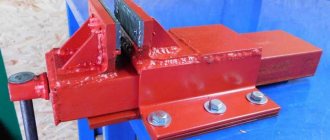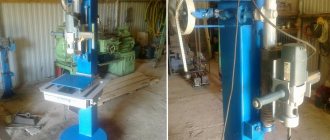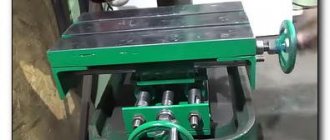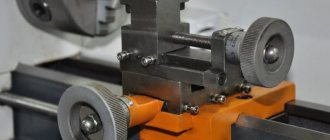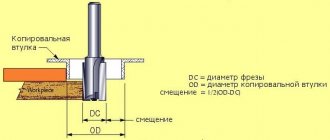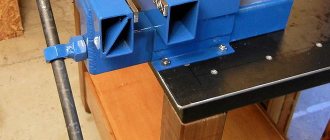Why do you need a bench vise?
When processing or sharpening any part, it is necessary to fix it firmly and reliably, that is, to hold it in a certain position. The photo of the vice shows the operating principle of this equipment.
The parameters and dimensions of the vice are determined depending on what type of tool needs to be firmly held.
The design of a carpenter's vice includes:
- chassis screw;
- handle;
- movable and fixed sponge;
- base plate.
Main types of bench vices
Before making a vice with your own hands, you need to decide on the choice of work associated with it.
All types of vices are divided into two types:
- non-rotating ones have a simpler design and are easiest to make yourself. The part is fixed strictly in one position.
- Rotary vices are most often adapted for drilling on a machine. During operation, it is possible to rotate the workpiece without unclenching it.
The material of the vice body is most often made of durable cast iron. It is important to know that cast iron is not intended to be exposed to high temperatures; steel metal is suitable for these purposes.
If the work will be carried out with small-sized parts, you should not increase financial costs and make compact small vices.
A small vice with a ball joint base is useful on the farm for processing very small parts that can be secured individually. These are mini-vises with suction cups, mounted on a glass or well-polished surface. But they are suitable for rare non-serious work.
Please note that it is wise to install soft attachments on the fastening part for working with soft parts, so as not to cause damage to them. A vice with the least amount of play when the jaws are fully extended is the ideal option.
A vice without a rotating mechanism will save a lot of money, unless, of course, it is needed in the work.
Work on making a bench vice at home
Carpenter's vices, made independently at home, will save the family budget significantly more than their store-bought ready-made “brothers”. And a huge plus is that the product can be made according to personal preferences and for certain individual types of work.
It is absolutely not difficult to find material for the structure; it could be: a piece of technical pipe, a used jack, old lathes, presses, etc.
And if you go to a metal collection point, there will undoubtedly be a suitable part for a vice that will cost you a penny.
Classic homemade vice
There are many types of vices, but the most popular and traditional is the type with steel material. Such a vice will be much more reliable than a factory-made one.
The structure consists of:
Note!
- a steel plate of at least 3 mm, but it can be much thicker;
- external and internal channel (120 and 100 mm);
- steel lugs;
- turning cutters 2 pieces;
- a small piece of reinforcement (rod for a gate);
- a nut (2 pieces), a pin or a screw of a certain diameter that corresponds to the rod;
- washer (2 pieces) of the same diameter with the lead screw;
- screw pair 335 mm;
- To secure the propeller chassis, a thick plate is needed.
It is necessary to separate the lead screw with washers on both sides of the plate. One of the two washers must be secured with a cotter pin or a locking ring, so that the part is completely removable; you must first weld the screw thread to it.
The handle should also be collapsible on one side, and welded on the other side using a nut. It is necessary to weld a nut with a channel from the screws flush to the plate. To make the channel inside with the screw move easier while moving, it is recommended to lightly process it with a file.
Sponges are welded to the so-called ears, made from turning cutters. They are placed in the right place when the lead screw is screwed in, so the ears stand at the ideal distance from each other.
But you can also connect them with wire for greater convenience, so in the future it will be more convenient to fix uneven parts, the shape of which is expanded towards the bottom.
These homemade vices allow you to process larger parts.
Note!
To perform work in a home workshop, it is recommended to choose the simplest fixed vice for the machine.
It’s not at all difficult to make them yourself, you just have to watch the videos and recommendations, which can be found without much difficulty on the Internet and first draw up the drawings correctly.
Manufacturing process
A homemade vice for a drilling machine should be assembled in stages.
Work technology:
- A 20*40 mm profile is installed between a piece of corrugated pipe approximately at a distance of 1/3 from one edge.
- It is recommended to secure the parts with bolted joints so that they can be periodically disassembled and lubricated with technical oil.
- Place the metal plate flat on the side 2/3 of the installed profile, capturing both corrugated pipes.
- This part will be welded on.
- On the opposite side of the base, weld a corner 8 cm long in the center.
- On the inside, a sponge will be attached to it with bolts.
- A 10 cm long corner will be located opposite a smaller corner. And accordingly, the second jaw is also attached to the bolts.
- The jaws should be positioned clearly opposite each other.
- Place the prepared pin with the end on which the nut is located on a metal plate. To ensure the rigidity of the connection, welding must be performed.
- The same pin with a washer at the end should be welded to the corner, which will provide direct contact with the workpiece.
- At the free end of the stud, a bolt or screw is installed in the hole of the washer to facilitate rotational movements.
Drawing of a small homemade vice
Upon completion of work, it is necessary to clean the equipment with a wire brush, degrease with a solvent, prime and paint the metal surface. This will provide protection from external influences and temperature changes.
The equipment is prepared and the drilling machine is complete. Hole drilling operations can now be carried out with confidence.
After all the work done, you can safely start using the vice
DIY vise photo
Note!
The use of a drilling machine requires that you clearly fix the element being processed and it will not move until the drilling process is completely completed. Only after a person is satisfied with the result can the part be removed and used in other conditions.
To clamp parts in the desired position, a table vice for a drilling machine is used. It is difficult to overestimate the importance and influence that machine vices have on the entire work process, which is associated with the manufacture and boring of various parts.
This article will talk about machine models of vices, their varieties and features.
Types of vices for drilling machines
Vices can be divided into two main groups:
- rotary;
- non-rotating.
Rotary vice
This type of vice allows you to fix a part, drill a hole in it in several places, without removing it from the clamping jaws. They can rotate 360 degrees, which makes it easy to drill the required number of holes without spending a lot of time. They are most often used in mass production, in plants and factories, when the number of parts made depends on time.
Some swivel clamps are equipped with cross guides
(cross vice). They allow you to move a fixed part not only at a certain angle, but also in a horizontal plane along two axes. It is quite difficult to make such a design at home, but there are several ways.
There is another type of rotary vice - globe or sine
. They allow you to move a fixed part in three planes, which significantly increases productivity. This type is only necessary for mass production. Globe vise allows you to make inclined holes in a part. It is interesting to watch their operating principle in the video.
Fixed vice
Often fixed vice
are called stationary. They are a design of two clamping jaws that fix the part in one position. The part cannot be moved without releasing the jaws. This type is very convenient when working with a drilling machine at home. They are quite easy to make with your own hands. The advantage is the affordable price.
Do-it-yourself vice for a drilling machine: types and instructions
instrument.guru > Do it yourself > Vise for a drilling machine with your own hands: types and instructions
A vice for a drilling machine is a necessary and expensive thing. They act as a retainer when working with a drilling machine. To ensure that the part is securely and firmly fixed, does not “walk” or move, clamping jaws are used.
There are a huge number of models on the modern market, all of them equipped with different functions. A vice is often not included with a drilling machine, so the question arises: is it possible to make one yourself? The answer is simple: of course you can.
You need to spend a little money to make a decent quality holding device.
- Types of vices for drilling machines
- Rotary vice
- Fixed vice
- Design and purpose of the vice
- Instructions for making a drilling vice with your own hands
Types of vices for drilling machines
Vices can be divided into two main groups:
- rotary;
- non-rotating.
Rotary vice
This type of vice allows you to fix a part, drill a hole in it in several places, without removing it from the clamping jaws. They can rotate 360 degrees, which makes it easy to drill the required number of holes without spending a lot of time. They are most often used in mass production, in plants and factories, when the number of parts made depends on time.
Some rotary clamps are equipped with cross guides (cross vise). They allow you to move a fixed part not only at a certain angle, but also in a horizontal plane along two axes. It is quite difficult to make such a design at home, but there are several ways.
There is another type of rotary vice - globe or sine . They allow you to move a fixed part in three planes, which significantly increases productivity. This type is only necessary for mass production. Globe vise allows you to make inclined holes in a part. It is interesting to watch their operating principle in the video.
Design and purpose of the vice
Drilling machine
Designed for drilling holes in various materials. If you need to drill a hole in soft plastic or wood, you do not need to use a workpiece clamp. This design is easy to hold with your hands. But if you need to form a hole in metal, then you can’t do without a vice. Firstly, it is very difficult to hold the structure with your hands, and secondly, this is prohibited by safety regulations. Clamps for a drilling machine are especially necessary when the workpiece needs to be secured at a certain angle.
Since the main function of drill press clamps is to secure the workpiece, the base of the structure is most often made of steel. Modern sellers offer a huge number of different models that are equipped with all sorts of functions. But the design always implies the presence of:
- Steel base - all other parts, the fixed part, are attached to it. There are always holes in the base for fixing to the floor or table.
- Fixed jaw - welded to the base.
- Movable jaw - connects to a screw that causes the jaw to move. This ensures clamping of the workpiece.
- Screw with handle - sets the movable jaw in motion and fixes the jaws at the required distance from each other.
- Plates - mounted on clamping jaws, made of durable metal, can have different shapes (angular, concave, flat).
Types of vices
There are three main types of vices for a drilling machine.
Fixed
This is stationary equipment with a simple design.
The vice is fixed on the machine in one position. A fixed vice allows you to make only one hole in the workpiece. If it is necessary to drill a part in several places, after the first processing it is removed from the machine, rotated at a different angle, clamped in a vice and the appropriate manipulations are carried out. This is done several times until the work is completed.
A distinctive feature of fixed vices is their increased structural rigidity. One of the disadvantages is that it takes a lot of time to carry out the corresponding operation. The main advantage is the affordable price.
Rotary
Devices of this type appeared on the market at a time when there was a need to make efficient and reliable clamping devices for processing workpieces in mass production conditions. Thanks to the presence of a special rotating platform, the jaws with the part fixed in them can rotate 360 degrees. Having drilled in one place, such a platform can be easily rotated to the required angle without loosening the part, and drill a hole in another place.
These are devices that allow you to make several holes on a workpiece without removing the element from the device, and the part can be rotated at different angles.
When selecting a rotary vice for a drilling machine, take into account the overall and mounting dimensions. More advanced models of rotary vices, due to the presence of cross guides on their base, allow you not only to rotate the clamping jaws to the required angle, but also to move them in a horizontal plane along two axes.
Making such a device with your own hands is much more difficult than a fixed vice, but it is possible if you wish. Such a device for a drilling machine can significantly increase the productivity of technological operations, which is especially important for mass production. There is another type of rotary vice for a drilling machine.
Their platform base with a rather complex design allows you to rotate the jaws with the part clamped in them in three planes. Such high-tech vices, which are very interesting to watch even on video, are called globe vices.
Globe rotary vise, due to its functionality, allows you to make inclined holes in parts. To solve this problem, you do not need to painstakingly select the correct position of the part in the jaws, which always takes a lot of time.
To make an inclined hole using a globe vice, simply fix the workpiece in it, and then use a special dial to rotate the movable platform of the device to the required angle. The described types of vices differ in varying degrees of versatility.
Expert opinion
Levin Dmitry Konstantinovich
For working on a drilling machine in a home workshop, it is best to choose a simple fixed vice. As mentioned above, they are easy to make with your own hands. However, before you start making them, you should stock up on drawings and watch the corresponding video on the Internet.
Universal
Such devices are used to perform any operations. Universal vices, in turn, can be longitudinally rotary and rotating in a 3D plane. The first devices allow you to rotate the workpiece in two axes. The second devices make it possible to perform work of any complexity. The disadvantage of universal vices for a drilling machine is their high cost.
Instructions for making a drilling vice with your own hands
Make non-rotating machine clamps
DIY is quite simple. Homemade vices for a drilling machine are convenient, economical, and their production does not take much time. When making homemade machine clamps, it is recommended to use strong metal, such as steel.
To make homemade clamps you will need: a base (a metal box in the shape of a rectangle with high ends, the inside must be hollow), two plates that act as clamping jaws, a screw, a lever, a clamp for the jaws (two small parts with which you can connect the movable sponge and screw), nuts.
The first thing to do is draw a drawing
future vices for a drilling machine, adjust all sizes. You can use a training video in which the dimensions have already been calculated. Then, you need to select or buy blank parts for homemade clamps. Once all the parts are in stock, you can begin production:
Each type of machine clamps
designed for a specific type of work. For home use, an inexpensive non-rotating vice is best. For mass production, it is certainly more cost-effective to purchase a rotary vice. Making homemade clamps is a simple and quick process. If you use the training video, the production time will decrease several times.
A vice is an indispensable device for a variety of jobs. A new tool is expensive, but it is extremely necessary at home.
The simplest and cheapest option is to make your own vice from materials that are easy to find. Today we will look at the possibility of making different types of vices ourselves.
DIY inclined vice for drilling and milling machines
Hello, dear readers and DIYers! This article will be of interest to anyone who works with drilling or milling machines, both with and without a movable table. In it, the author of the YouTube channel “TheDacchio” will tell you how to make a device for working on a drilling or milling machine. This is an inclined vice that will allow you to process the part at the desired angle. Be it the process of drilling holes or milling the ends of parts.
Materials. — Steel profile pipes — Steel strip — Steel bar — M10 stud — Bolts, nuts, washers — Extended M10 nut — Wing nuts — Cooling spray.
Tools used by the author. — Automatic welding machine — Band saw — Vise — Grinder with flap cleaning disk — Tap — Drilling machine — Milling machine with movable table — Clamps, angle, tape measure, caliper, marker.
Manufacturing process. First of all, the author, having lubricated the workpiece from the profile pipe, cuts it into parts of the required size using a band saw. This can be done on a miter saw, or just with a grinder.
Then he assembles the structure of the base of the vice and welds it at several points.
Due to the fact that the author welds with argon blowing, sometimes smoke comes out of the profile pipe. Checks the geometry of the workpiece using a corner.
Starts making the vice screw. Drills a thin hole in the end of the stud.
Then, having cut a thread in it, screws the thick washer with a bolt.
Good mood to you all!
Source
Become the author of the site, publish your own articles, descriptions of homemade products and pay for the text. Read more here.
Base and movement mechanism
The base of the vice consists of a sheet and two corners welded to it at the edges.
Attention! Remember, to prevent the structure from jamming, it is important for us to maintain the distance between the corners by the width of the channel plus 0.5-1 mm.
Base assembly
Therefore, before welding the corners to the sheet, install a channel in the middle, and along the edges, between the channel and the corner, a piece of cardboard or, if available, several transformer plates.
Movement mechanism
After welding the corners, draw a line in the center of the base and position the prepared nuts. To do this, screw them onto an M16 screw.
You can place regular staples from a stapler under the screw to lift it closer to the middle of the frontal plane.
Look at the photo, everything will become clear. And we make an indent from the edge of the sheet inward by 5 - 6 mm.
Stapling staples
To fill the space between the nut and the base of the vice, you can place a 3-4 mm plate.
Remember! How accurately you set the nuts will determine how well the movement mechanism will work.
After installing the nuts, you can install the cover. The body should look like in the photo.
Housing assembly
At this stage, check the free movement of the channel; if it is very tight, then remove 0.5 -1 mm. from the walls. The walls will then be not 40, but 39 mm.
Checking progress
Next, on one side of the channel, overlapping, we weld a corner and, installing it in the body, mark the place for drilling the hole for the counter nut. We also cook turns to the base. It should look like in the photo.
Housing and movement mechanism assembled
The next step is to weld the remaining turns from the pipes onto the counterpart of the vice, cut out and attach the jaws. That's all. We install the pin and fasten it from the inside to the moving part of the vice as in the photo.
Moving mechanism pin
The final stage is to paint, dry and put everything together.
The final stage, painting. The product is ready.
Bench vice made from corrugated pipe
In order to make a reliable bench tool yourself, you need a welding machine and the following components:
- Several sections of professional pipe of different sizes.
- Hardened steel stud with coarse thread.
- Double height nuts.
The vice used for equipment performs a very important function. They provide reliable fixation of the part, which is necessary for drilling to be performed with maximum accuracy. The modern market offers a wide variety of models of vices for drilling machines. Each of these models has its own design features and areas of application.
Homemade machine vise for drilling machine
» Machine » Vise for drilling machine
The vice used to equip a drilling machine performs a very important function. They provide reliable fixation of the part, which is necessary for drilling to be performed with maximum accuracy. The modern market offers a wide variety of models of vices for drilling machines. Each of these models has its own design features and areas of application.
Machine vice made of cast iron, designed for simple drilling operations
Purpose and use of a vice for a drilling machine
Drilling machines, which can be either floor-mounted or tabletop, are designed to form holes in parts made of different materials. As mentioned above, a vice for drilling machines allows you to perform such a technological operation with maximum accuracy and safety.
Not all models of drilling equipment have a vice in their basic configuration. The latter, although slightly, increase the cost of the machine. The absence of such a device as a drilling vice in the basic configuration of the equipment is also explained by the fact that when working with workpieces made of soft materials (wood, plastic, etc.), they may not be required. When drilling holes in such materials, very small cutting forces are created, and it is not difficult to hold the workpiece with your own hands.
You definitely cannot do without a vice if holes are drilled on a machine in parts that are made of metal. In such cases, holding the workpiece with your own hands is not only difficult and ineffective, but also unsafe.
Machine vices are especially indispensable in cases where the part must be positioned at a certain angle to perform drilling. Of course, instead of a vice for a drilling machine, you can use simple clamping devices that are not difficult to make with your own hands. However, if you are interested in the reliability of fixing the workpiece, the safety of work on the machine and the high accuracy of the technological operations performed, it is better to purchase serial models. In most cases, a homemade vice for a drilling machine will cope with such tasks.
Drawing of a small-sized homemade vice: 1 – body; 2 – movable sponge; 3 – screw; 4 – bushing; 5 – knob; 6 – clamp; 7 – washer; 8 – pin (click to enlarge)
Technology for making homemade vices for a drilling machine
Not all models of machine equipment are produced together with a vice. If purchased separately, they are quite expensive. It is easy to make a machine vice yourself. To do this, you can use handy materials.
Technological operations for drilling holes on specially designed equipment are performed using a vice. With the help of the latter, the workpiece is securely fixed, which allows you to adjust the working drill with maximum precision. The metal used to make the equipment is durable, otherwise the device will quickly wear out.
Preparation of materials
To make a machine vice, you should prepare the following materials:
Base;
Vise diagram
- Base.
- Metal plate 35 mm wide, 8 mm thick.
- Profile pipe size 20*40 mm, length 5 cm
- Two corners 50 * 50 mm, 10 cm and 8 cm.
- Jaw strips
- A stud with a nut and a bolt head with a hole at one end. There is also a hole at the end of the pin.
- A locking nut should be prepared on the free end of the stud, with a washer placed on top of it.
In order for the equipment to be stable on the platform of the drilling machine, it is necessary to make a base. It is proposed to use a 20*20 mm corrugated pipe as this element. The length of the workpieces can be made different, taking into account the size of the working base of the drilling machine.
For sponges, it is proposed to use strips made from old files. They should first be calcined to ensure strength and two holes should be drilled in each of them for fastening the bolts.
Each part should be sanded individually or cleaned with a wire brush to remove burrs and other metal defects.
Some details have been prepared. You can start making the device.
Manufacturing process
A homemade vice for a drilling machine should be assembled in stages.
Work technology:
- A 20*40 mm profile is installed between a piece of corrugated pipe approximately at a distance of 1/3 from one edge.
- It is recommended to secure the parts with bolted joints so that they can be periodically disassembled and lubricated with technical oil.
- Place the metal plate flat on the side 2/3 of the installed profile, capturing both corrugated pipes.
- This part will be welded on.
- On the opposite side of the base, weld a corner 8 cm long in the center.
- On the inside, a sponge will be attached to it with bolts.
- A 10 cm long corner will be located opposite a smaller corner. And accordingly, the second jaw is also attached to the bolts.
- The jaws should be positioned clearly opposite each other.
- Place the prepared pin with the end on which the nut is located on a metal plate. To ensure the rigidity of the connection, welding must be performed.
- The same pin with a washer at the end should be welded to the corner, which will provide direct contact with the workpiece.
- At the free end of the stud, a bolt or screw is installed in the hole of the washer to facilitate rotational movements.
Drawing of a small homemade vice
Upon completion of work, it is necessary to clean the equipment with a wire brush, degrease with a solvent, prime and paint the metal surface. This will provide protection from external influences and temperature changes.
The equipment is prepared and the drilling machine is complete. Hole drilling operations can now be carried out with confidence.
After all the work done, you can safely start using the vice
How the equipment works
Homemade vices perform their intended function as follows:
Vise mechanism diagram
- The free end of the pin with a screw at the end is turned out, which makes it possible to move the movable jaw away from the fixed one.
- A workpiece is placed between the jaws, with markings made in advance for drilling a hole.
- The pin is twisted until the workpiece is securely clamped.
The workpiece is now placed on the work platform and the drill press is ready to start and perform tasks.
Safety precautions
When performing work, do not forget about your own safety. List of occupational safety measures:
- Wear clothing that protects exposed areas of the body.
- Shoes must be closed-toed (you cannot work in sandals, flip-flops or slippers).
- Use safety glasses, or better yet, a face shield.
- There must be a headdress on the head.
- There should be no foreign objects in the workplace.
Safety precautions on the drilling machine
Design and principle of operation of clamping devices
Since machine vices are necessary to securely hold the workpiece during processing, they are made of durable steel elements. Depending on the type and purpose of the machine vice, their design can vary significantly.
The most inexpensive and least functional are the fixed-type vices, but these models have the most rigid design. By the way, homemade vices for a drilling machine are most often non-rotating.
The mid-price category includes rotary models, the functionality of which allows drilling operations to be performed more efficiently. The advantages of vices of the first and second types are combined in universal devices for a drilling machine, which, naturally, makes the cost of such devices quite high.
Even vices of the same type, but produced by different companies, may have certain design differences. This is explained by the fact that each manufacturer tries to provide their products with additional options, to make them more reliable and convenient to use.
Whatever functionality the machine vice has, the basis of its design is made up of mandatory elements, which include:
- strips that act as the base of the vice;
- two jaws that provide clamping of the workpiece;
- a screw with a handle, which ensures the movement of the movable clamping jaw;
- plates that serve as working elements of the clamping jaws;
- a number of additional details.
The bar, which acts as a base, is the supporting element on which all other parts of the vice are fixed. It is on the bar, which is made of hard and wear-resistant metal, that a hole for the screw is drilled and the movable and fixed jaws are mounted. To ensure precise movement, there is a rectangular shank on the bottom of the movable jaw, which is inserted into a cutout made on the fixed jaw.
The screw responsible for moving the movable jaw is connected to it, which is ensured by a special locking ring. Rotating in the threaded hole of the base plate, the screw moves the movable jaw, thereby ensuring clamping of the workpiece processed on the drilling machine. To understand how a vice works, you can watch the corresponding video.
Both serial models and homemade vices for a drilling machine can be made according to different patterns of screw action on the movable jaw. In the simplest models of a vice, which are easy to make with your own hands, the screw is directly connected to a movable jaw, which it either pulls (unclamps the jaws) or pushes (compresses the jaws), which depends on the direction of its rotation. In more complex models, which may include both fixed and rotary vices, rotation of the screw is transmitted through gear drives, which makes the work of the drilling machine operator easier. Thanks to the gear drives, very little force is required to compress or unclench the jaws of the vice.
It should be borne in mind that the presence of a gear mechanism is not at all a criterion that should be emphasized when choosing clamping fixtures for a drilling machine. Many well-known manufacturers, whose products are popular with specialists all over the world, produce devices whose operating principle is implemented according to a standard scheme, which does not make them less effective or inconvenient to use.
Important structural elements of any type of vice, which experience significant loads during operation and ensure reliable fixation of the workpiece, are pressure plates, or strips. Such elements, made of durable metal, are attached to the working surfaces of the clamping jaws using screw connections.
In the standard version, the clamping bars have a flat working surface, on which a cross notch is applied. More specialized types of planks are also used, which are necessary for processing workpieces of a certain shape. The working surfaces of such planks can be made in various shapes (angular, concave, etc.). In some modern vise models, the clamping bars may be spring-loaded. This design makes it possible to slightly increase the convenience of fixing parts in the clamping fixture of a drilling machine.
Vise for drilling machine
» Machine » Vise for drilling machine
The vice used to equip a drilling machine performs a very important function. They provide reliable fixation of the part, which is necessary for drilling to be performed with maximum accuracy. The modern market offers a wide variety of models of vices for drilling machines. Each of these models has its own design features and areas of application.
Machine vice made of cast iron, designed for simple drilling operations
Purpose and use of a vice for a drilling machine
Drilling machines, which can be either floor-mounted or tabletop, are designed to form holes in parts made of different materials. As mentioned above, a vice for drilling machines allows you to perform such a technological operation with maximum accuracy and safety.
Not all models of drilling equipment have a vice in their basic configuration. The latter, although slightly, increase the cost of the machine. The absence of such a device as a drilling vice in the basic configuration of the equipment is also explained by the fact that when working with workpieces made of soft materials (wood, plastic, etc.), they may not be required. When drilling holes in such materials, very small cutting forces are created, and it is not difficult to hold the workpiece with your own hands.
Using a vice when drilling metals significantly increases the accuracy and safety of work
You definitely cannot do without a vice if holes are drilled on a machine in parts that are made of metal. In such cases, holding the workpiece with your own hands is not only difficult and ineffective, but also unsafe.
Machine vices are especially indispensable in cases where the part must be positioned at a certain angle to perform drilling.
Of course, instead of a vice for a drilling machine, you can use simple clamping devices that are not difficult to make with your own hands.
However, if you are interested in the reliability of fixing the workpiece, the safety of work on the machine and the high accuracy of the technological operations performed, it is better to purchase serial models. In most cases, a homemade vice for a drilling machine will cope with such tasks.
Drawing of a small-sized homemade vice: 1 – body; 2 – movable sponge; 3 – screw; 4 – bushing; 5 – knob; 6 – clamp; 7 – washer; 8 – pin (click to enlarge)
Design and principle of operation of clamping devices
Since machine vices are necessary to securely hold the workpiece during processing, they are made of durable steel elements. Depending on the type and purpose of the machine vice, their design can vary significantly.
The most inexpensive and least functional are the fixed-type vices, but these models have the most rigid design. By the way, homemade vices for a drilling machine are most often non-rotating.
The mid-price category includes rotary models, the functionality of which allows drilling operations to be performed more efficiently. The advantages of vices of the first and second types are combined in universal devices for a drilling machine, which, naturally, makes the cost of such devices quite high.
Even vices of the same type, but produced by different companies, may have certain design differences. This is explained by the fact that each manufacturer tries to provide their products with additional options, to make them more reliable and convenient to use.
Professional machine vices can be equipped with various clamping bars
Whatever functionality the machine vice has, the basis of its design is made up of mandatory elements, which include:
- strips that act as the base of the vice;
- two jaws that provide clamping of the workpiece;
- a screw with a handle, which ensures the movement of the movable clamping jaw;
- plates that serve as working elements of the clamping jaws;
- a number of additional details.
The device of the simplest machine vice
The bar, which acts as a base, is the supporting element on which all other parts of the vice are fixed. It is on the bar, which is made of hard and wear-resistant metal, that a hole for the screw is drilled and the movable and fixed jaws are mounted. To ensure precise movement, there is a rectangular shank on the bottom of the movable jaw, which is inserted into a cutout made on the fixed jaw.
Shank responsible for the parallel movement of the jaws
The screw responsible for moving the movable jaw is connected to it, which is ensured by a special locking ring. Rotating in the threaded hole of the base plate, the screw moves the movable jaw, thereby ensuring clamping of the workpiece processed on the drilling machine. To understand how a vice works, you can watch the corresponding video.
Both serial models and homemade vices for a drilling machine can be made according to different patterns of screw action on the movable jaw.
In the simplest models of a vice, which are easy to make with your own hands, the screw is directly connected to a movable jaw, which it either pulls (unclamps the jaws) or pushes (compresses the jaws), which depends on the direction of its rotation.
In more complex models, which may include both fixed and rotary vices, rotation of the screw is transmitted through gear drives, which makes the work of the drilling machine operator easier. Thanks to the gear drives, very little force is required to compress or unclench the jaws of the vice.
It should be borne in mind that the presence of a gear mechanism is not at all a criterion that should be emphasized when choosing clamping fixtures for a drilling machine. Many well-known manufacturers, whose products are popular with specialists all over the world, produce devices whose operating principle is implemented according to a standard scheme, which does not make them less effective or inconvenient to use.
Hydraulically reinforced vice provides stable compression, independent of shock and vibration
Important structural elements of any type of vice, which experience significant loads during operation and ensure reliable fixation of the workpiece, are pressure plates, or strips. Such elements, made of durable metal, are attached to the working surfaces of the clamping jaws using screw connections.
